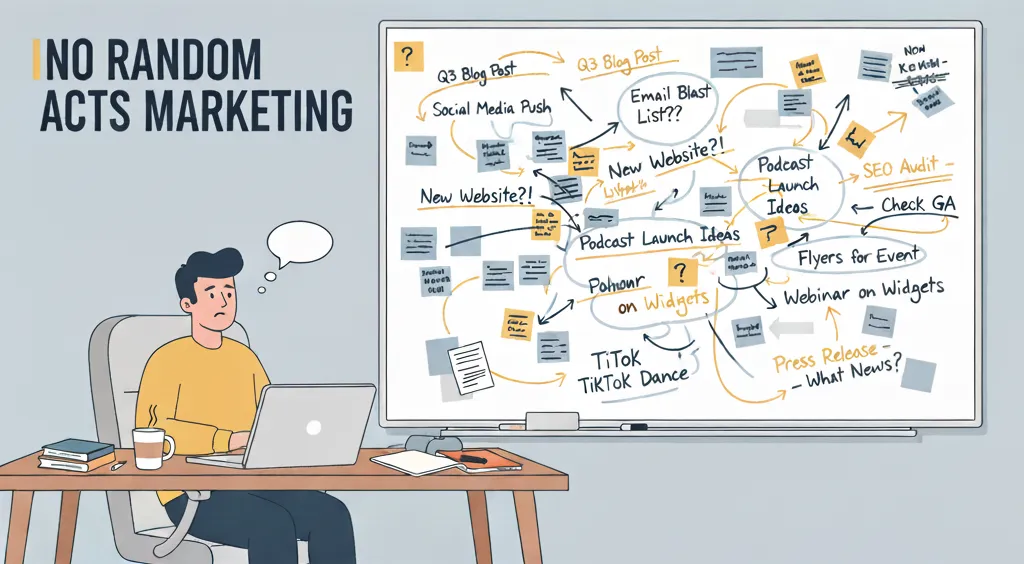No random acts of marketing
It’s process, not AI, that fixes this (but AI can help)
Every marketing team is guilty of this, doesn’t matter if you’re one person or 100. Random acts of marketing crop up—and usually out of the blue. The odd thing is—at least for a “Marketing Department”—no one plans to have a mess of these random acts clogging the works. No one working on their marketing plan says “Okay we’re going to reach into the hat and pull out a slip with a marketing tactic to do…,” but somehow it always happens.
Here’s how it usually seems to go.
Someone in the company sends an email/Slack message/wanders by your desk and says: “Hey, we need more leads/downloads/registrations. We need to launch a marketing campaign to ‘fix this’. Now!” and we respond “Okay, on it.”
Cue random act of marketing fire drill.
Marketing briefs are crucial, but we’re doing them wrong
I always chafed at doing a marketing brief. It always seemed like a waste of time. I know what I’m doing and why are you making me write this down? Especially if I’m the one who’s going to actually do the thing. Why do I need to have a brief for myself?
Seems pretty silly, right?
Wrong.
A brief is crucial not just because it outlines important things like:
- What are we going to measure?
- What’s the goal?
- Who’s the target
- Timelines
- Resources
Those are important, yes, but that’s not actually why the process of doing a marketing brief is crucial.
Slow down, you move to fast
I recently read ’s book Valuable Friction. It’s a really great read; highly recommended. In his book, Robert talks about this idea of valuable friction as putting a pause, a speed bump, a delay in whatever you’re doing to just take a moment to think. Something we’ve beaten out of marketers in the name of “move fast and break things” and “fail fast” marketing.
Since reading the book, I’ve come to realize that’s really what a marketing brief is supposed to be for. Friction, the valuable kind. Done right, a marketing brief should make us stop and think about what we’re doing and why. It’s a moment when we can ask, “Hey, is this really the right campaign right now?”
Because if you treat it like some kind of rote exercise where you’re thinking: “Dammit. I got to fill this in before I can do what I need to do. This is so stupid. I don’t understand why this is important.” you’ve missed the point (more likely, no one ever explained the “why” behind the brief in the first place).
But I digress.
As I’ve (finally) figured out, it’s the process of thinking about these questions, that’s just as (more?) important than the output itself. But here’s the problem,whenever I’ve tried to do marketing briefs, especially when I’ve tried to automate them with a simple form, it’s always been with the mindset of, “Let’s fill this out as quickly as humanly possible because it’s slowing me down.”
Which not only made the brief thin; I was still missing the point of a brief myself.
Using Campaign Briefs as Strategic Marketing Tools
While I was creating the marketing campaign brief prompt for EasySOP.ai, I followed my process of writing a prompt to have Gemini help me write the actual prompt I needed. That process of writing a prompt to make a prompt gives me the opportunity to refine my ideas. Forces me to think/ask, “Is that what I want? Is this the order I want? What’s the important thing to ask? And why am I asking it?”
This is where the first subheading comes in—it’s process, not AI, that prevents random acts of marketing, the next subheading—marketing briefs are crucial, but we’re doing them wrong, and this section—marketing briefs as strategic marketing tools.
When we look at marketing briefs solely as a check mark on the to-do list for getting something going, we’re missing an opportunity to insert some space, some friction, to think about what we’re doing. Simple forms made to be filled in fast, gathering the bare minimum and requiring no thought, open the door for “random acts of marketing.” When briefs are saved into a folder, checked off as “brief done,” and never to be heard from again, we don’t see how those other briefs in that same folder connect to each other. Which might be a topic for a later post.
A good marketing brief should do a couple of really important things. First, capture the core information about the campaign:
- What are you doing
- Who’s the market
- When do you need it by
- What are we going to measure
- What resources do you need
Those are all crucial because otherwise you have nothing to go on to actually do anything. Second a brief should force someone to answer questions in a way that helps them reflect on those first questions and how the campaign connects to the larger marketing strategy. That’s what will make a really strong brief.
For example, in my marketing brief prompt, the prompt asks, “What are the goals for this campaign?”and if the the user gives something simple like “downloading our case study,” the prompt will help guide the user to make that a SMART goal (specific, measurable, achievable, relevant, and time bound). The goal isn’t, “download the case study” it’s “We want to have 100 downloads of the case study within 30 days and 75% of those downloads should come from our key ideal customers.”
A prompt structure that asks good questions and nudges for good answers, makes a really good brief in the end. The back and forth, interview-style structure makes this a more interactive process where the answers to questions can spur more questions that reveal blind spots or things like:
When do you need this by? I need it by October 1st. Well it’s September 26th right now and you need graphics, a blog post, and approvals.
While a prompt can’t know “time” like that, a question like “Have you confirmed this timeline fits with all the resources and approvals required?” puts that pause in to wonder if your timeline is “overly optimistic.” Making sure you’ve thought through all the facets like budget, channel, CTA, strategic fit, and who’s responsible for what, means when the brief is used for generating ideas, drafting content, and getting the work done there is enough to go on.
Creating processes for friction that get things done right
If you’re thinking, “Jeez, that seems like a lot of work” you’re right—and wrong. When chefs cook meals they follow mis en place (in its place) religiously. Everything is ready to go: veggies chopped, spices measured, sauces ready, protein set, tools at hand, dishes within reach. I’m not trained as a chef, but that’s how my dinner prep goes. It makes cooking a lot smoother when I don’t have to stop to do something before I can follow a step (and you burn your food less).
A brief creation prompt/process is no different. It’s marketing mise en place. It’s having the fundamentals in place first, before the work starts. It’s making sure you’ve defined your personas. It’s having a brand voice guide to influence brainstorming. It’s making sure you don’t skip steps that are crucial to success. And it’s leveraging AI tools to help you through the seemingly rote parts to get to a better outcome.
And that’s how you prevent random acts of marketing.
BTW, if you download the EasySOP mini persona playbook you’ll have a prompt to ask your personas what they think about your ideas.
AI-enabled Marketing Consulting
I’m available for full-time, fractional, and freelance content development, marketing, and AI implementation work. Get in touch or book 30 minutes in my calendar, and let’s see how I can help you.

